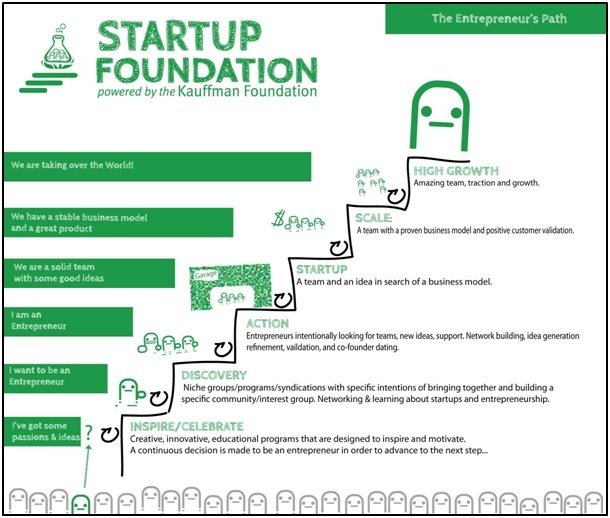‘The value of an idea lies in the using of it’ ~ Thomas A. Edison.
Ola, Exotel, Housing, Uber, Slack, Zenefits and many others are hot names we regularly hear in the news these days with soaring market shares, innovative new hiring techniques and highly lucrative pay and rewards packages. Start-ups are the conglomerates of today creating stark positions for themselves in the markets and serving as the cynosure of the job market.
The life-cycle of most start-ups can be summed up in the picture shown below.

Fig: The Life cycle of a start-up
Beginning with an inspiration coupled with ideas and passion of one or more individuals, the journey of a start-up undergoes several stages. The most essential step is the individual’s discovery of wanting to be an entrepreneur. This is based on his/ her interest and motivation about entrepreneurship and leads to networking and research. This further stems into building of desirable teams, building network and support, idea refinement, in short the preparation of starting out. Once the preparation phase is completed and a business idea is agreed upon, the start-up is formed. This is followed by scalability of the start-up through a stable business model, and further high growth and sustainability in the market.
Branden Spikes, the CEO of Spikes Security which provides high performance software solutions, quit a 15-year long career as Chief IT Officer at various computer security enterprises to launch Spikes. Heather Holmes, a well-recognized reporter and senior management personnel for several medical technology companies, created her own firm TapGenes in the middle of an official stint in Singapore. The company now is known as one of the fastest growing health & preventive medical aid providers. Such stories serve as an inspiration for budding entrepreneurs. However with the growing vogue for start-ups among young professionals, it is essential to analyze the financial footprint of quitting a well-established job to pursue one’s dreams.
The most important factor to consider when deeming to joing a start-up is the feasibility and viability of its business model. As can be seen from the figure below, successful start-ups can be easily identified.
The three ingredients that constitute a successful start-up are:
- People: The most essential instrument that drives an organization’s success is its people. How well an organization’s recruitment strategy is, how well its people function together and how adroit its policies and functions are determines how well the organization performs. A close-knit organization with an open and informal culture allowing its people to innovate, at the same time encompassing a rich heritage of strong and well-built values and ethics serves as a budding ground for a highly successful, fast- growing and continuously evolving organization. Such an organization attracts the right kind of talent, keeps its employees motivated and engaged, displays high productivity and profitability by continuously producing out-of-the-box ideas and shows early signs of maturity and leadership.
- Market & Competitors: The next instrument that determines an organization’s success is the market it operates in. Start-ups with ultra-cool & innovative business plans and products such as Kolos, Bluebird, Zagreb Cohousing and Keep Fit Stay Sane faced disheartening downfalls within 2-3 years of their conception. Reasons for the same ranged from ‘Not something people wanted’, ‘lack of financial & operational controls paired with inexperienced management’, ‘Wrong place, wrong target’ to ‘Couldn’t find a market’. These failures clearly demonstrate the importance of sustainable business models, essential products and the right market for a start-up to be successful. It is essential that the pricing strategy of the product be minimum viable so that it can be sustained in the market. In addition, threats from competitors with pre-existing established brands as well as new-entrants needs to be analysed carefully before a product is launched.
- Product:Despite well thought-out market and competitor strategies, start-ups have been known to fail due to products which were not really needed by consumers, or due to the existence of alternate products by competitors and established brands. Classic examples of such collapses are Outbox, Shnergle and Pollarize. Hence, pilot runs before launching a product are extremely essential in order to assess customer response and gather feedback about the feedback. In cases where encouraging public responses are not obtained, it is better not to launch the product and avoid incurring huge losses in the future.
For a start-up to be successful, it is essential to follow a six step strategy. The first step is to define the Business and the company’s Vision. This step defines what the company does, what the future plan for growth is and who its customers are. This step is critical as it serves as the driving force for the setup and growth of the organization. The second step is setting of goals- both short term and long term- for the organization. A lot of research goes into planning of short-term goals and how the company plans to achieve it. This step answers three basic questions- What you want to achieve? How you want to achieve it? What is your primary competitive advantage and how it makes an impact on the consumer? The third, and most essential step, is understanding your audience. It is imperative to understand who your target market are and what are their needs and wants. In this case, pilot runs of the product can help understand product perception and problems faced by consumers and help apply corrective strategy for better brand positioning. The fourth step is competitor strategy analysis. It is essential to first identify who your competitors are, and next what strategy they adopt. Competitor’s strengths and weaknesses, target market, pricing and marketing strategy help the company position its own strategy in-line with both customer and market needs. The fifth step is identifying the organization’s financial strategy. This involves planning for the start-up investment, monthly overhead cost, sales forecasts and break-even point for the organization. The sixth step is setting up a thriving marketing strategy that will help consumers adapt the product fast and ensure maximum satisfaction.
Hence, the success story of a start-up largely depends on its people, its products and its market positioning. More often than not, when planning to start a new venture, it is essential to be prepared to embrace failure if the product, market and pricing strategy is not well thought-out before-hand. It is equally essential to identify the right mix of people and personalities suitable to drive the growth and success of your organization. If your team isn’t like-minded or doesn’t support pace, change and innovation, it is hard to guarantee success of the company. An analysis of both successful and unsuccessful start-ups will help your venture analyse the steps to be taken and those to be avoided for a successful, sustainable and lasting organization.
References:
- fnf.com
- https://fi.co
- http://autopsy.io/
- http://www.successfulstartup101.com/
The article has been written by Apurvi Maheshwari. She is presently pursuing her MBA from XIMB.
Tags: business strategy Startups StrategyYou might like reading:

Mobilization – The Next Era of Living
The term Mobilization means “Mobile Civilization” which originated way back in 1973 when Dr Martin Copper of Motorola laid the brick but it is the next decade , we would experience the realization of that brick into a civilization . As quoted by the great philosopher Sigmund Freud “Civilization began the first time, when an angry person cast a word […]

Rajkumar Jha , TEDxNMIMSBangalore 2014
India lives in villages, with most of the people involved in agriculture. Illiteracy, poverty and illness surround them. Urbanization and top down approach on the name of social and developmental programs is farce. The people who moved out of villages and small towns do not look back and contribute to villages. “It hurts” to see their indifferent behavior. Will staying […]































